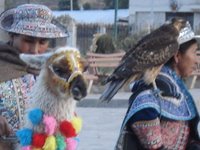





Llama's: The top 3 are llama's. They´re bigger than alpaca´s, have banana-shaped ears and tails that point upwards. Since grass doesn´t grow at high Andean altitudes, donkey´s and oxen cannot survive at these heights. Llama´s can survive on the mountain shrubbery and are thus ideal for transport (their primary use).
Alpaca´s¨: They have superior fleece, great for poncho's and beenies. Alpaca's are often seen on the menu in Peru (tastes sort of like a mix of beef and liver but delicious).
Vicuñas (at the bottom): Unlike the llama and alpaca, these cannot be domesticated. Their short fleece however is better than the alpaca´s (almost silky). Once every two years a festival is held where the locals round up the vicuñas and collect their fleece. 1 kilo = 1200 USD.
Strange observation: The word 'Llama' is borrowed from the Quechua language. So is 'Poncho'!

No comments:
Post a Comment